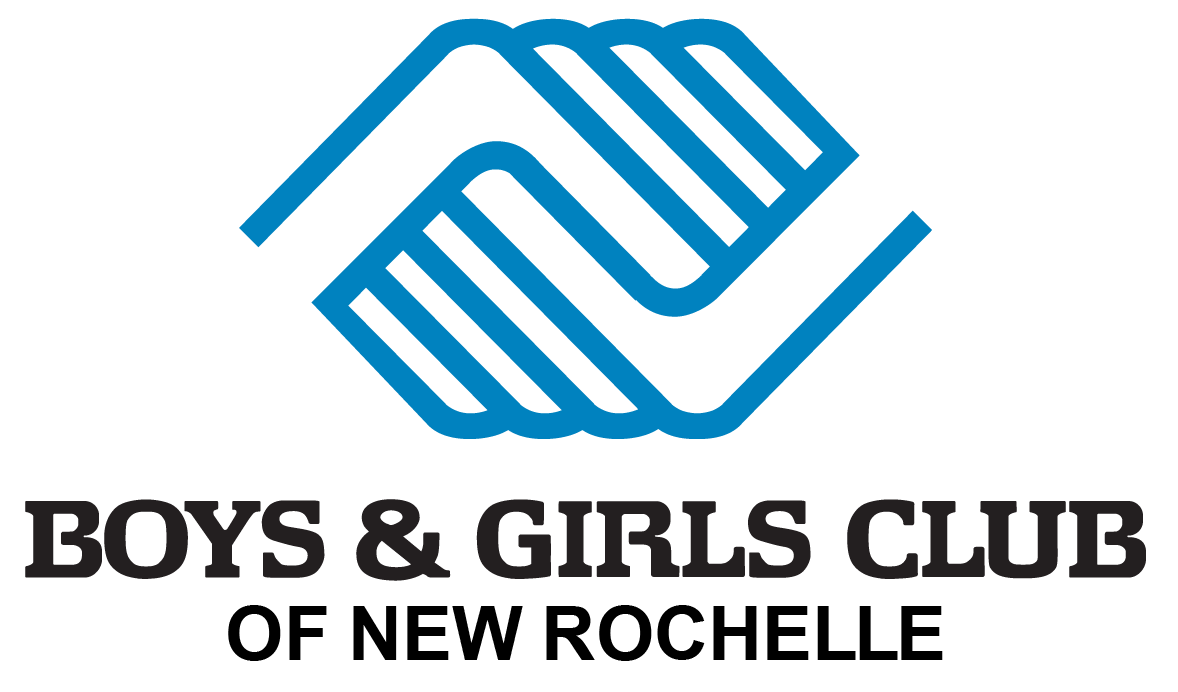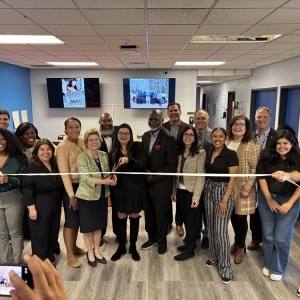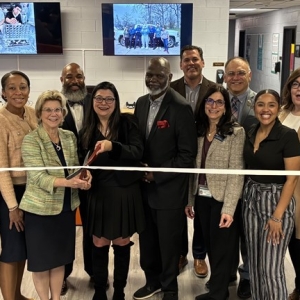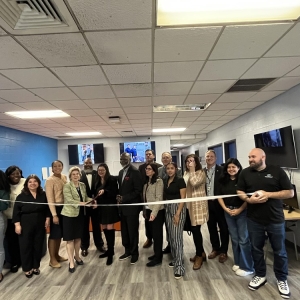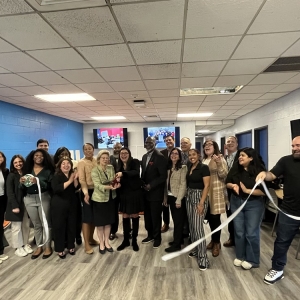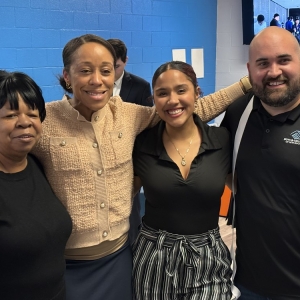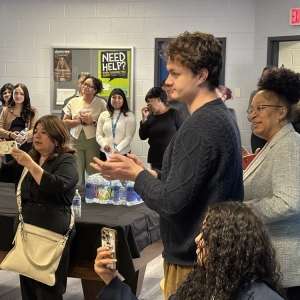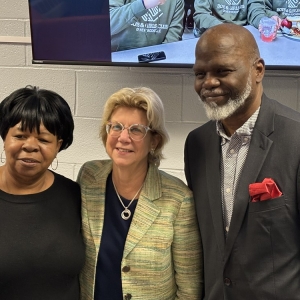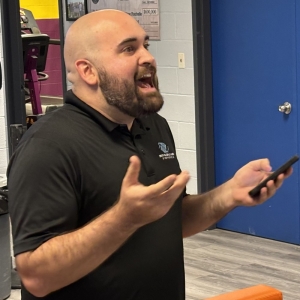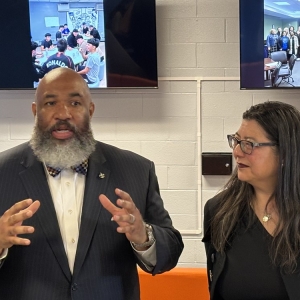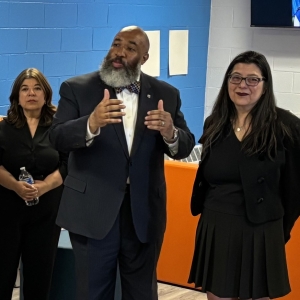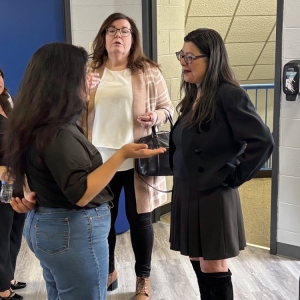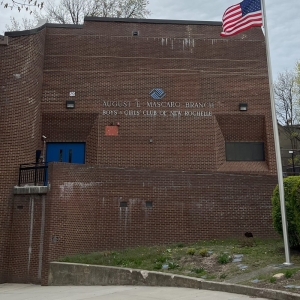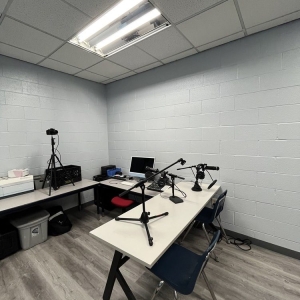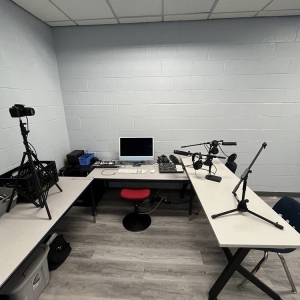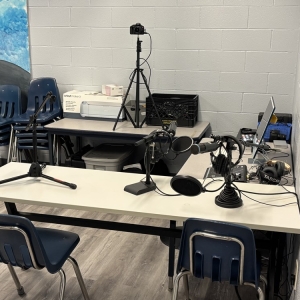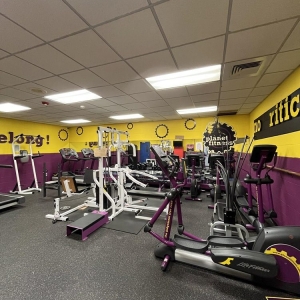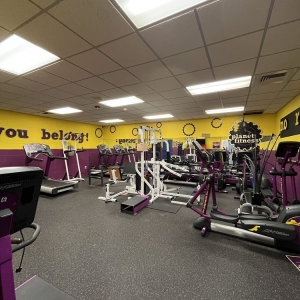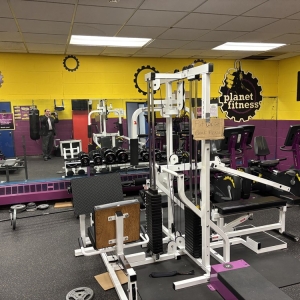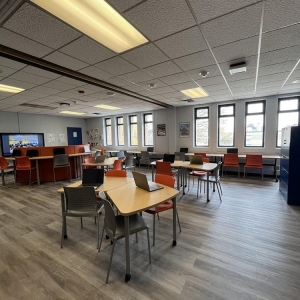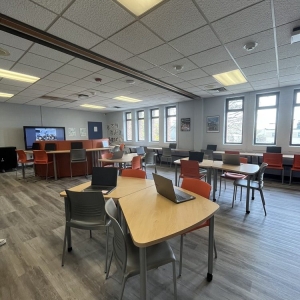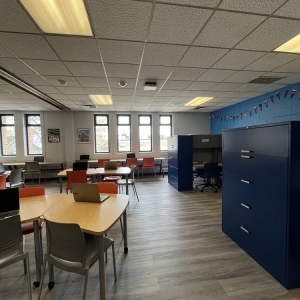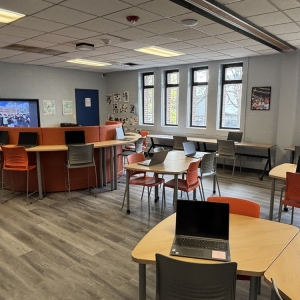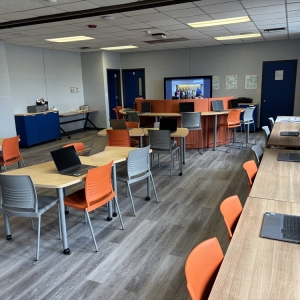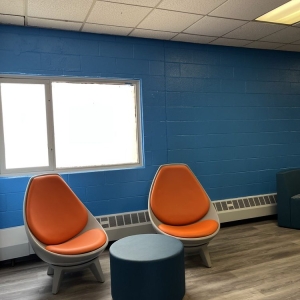Mascaro Clubhouse
Boys & Girls Club of New Rochelle Unveils Newly Renovated Teen Center at Mascaro Clubhouse, Expanding Programming and Services
The Boys & Girls Club of New Rochelle debuted its new Mascaro Clubhouse Teen Center on April 21, 2025, home to programs and services that support career development, college prep and leadership initiatives while doubling its capacity to serve youths and equip them for bright futures.
The transformational renovation, celebrated at a ribbon-cutting attended by about 50 dignitaries on April 21, 2025, was made possible through a generous grant from New York State Senator Shelley B. Mayer.
“This Teen Center will have a profound positive impact on the lives of our teens and serve as an innovative safe haven for our young people,” said Becky Mazzanobile, CEO of Boys & Girls Club of New Rochelle. “They deserve a space that reflects their potential, and that’s exactly what this vision and renovation represent.”
“This renovation truly transforms this space and creates incredible opportunities for the young people in this community,” Senator Mayer told attendees. “I’m proud to have played a role in helping bring it to life and I always strive to support projects that have a meaningful and lasting impact. We’re committed to ensuring that every young person feels supported, inspired and valued in the environments where they learn and grow.”
Originally donated by the Ricci family in 1926, the Mascaro Clubhouse began as a residential home before being destroyed by a fire in the late 1970s and rebuilt in the 1980s. Today, the 22,000-square-foot facility serves as a cornerstone, along with the Club’s Remington Clubhouse, of youth development in New Rochelle. The Mascaro renovations are components of a larger capital project that will continue to unfold in future years.
The ribbon-cutting ceremony was attended by elected officials and community stakeholders, including New Rochelle Mayor Yadira Ramos-Herbert and City School District of New Rochelle Superintendent Dr. Corey W. Reynolds. These leaders joined others in recognizing the Club’s ongoing commitment to expanding resources and opportunities for youth in New Rochelle.
Mayor Ramos-Herbert congratulated the Boys & Girls Club on the opening, emphasizing the importance of the Club’s expanded programming. “The new Teen Center is more than just a space; it’s a launchpad for our youth,” she said. “The programs housed here will open doors for teens to explore careers, prepare for college and build confidence in a safe, innovative environment. We’re proud to support the Boys & Girls Club of New Rochelle as it continues to invest in the future of our city’s young people.”
New Rochelle High School senior Alexa Arias, a Club member, shared her excitement about the new space. “This new Teen Center represents growth for our Clubhouse and opens up so many new possibilities to grow both academically and socially. I’m so excited to be able to use this space,” she said.
Last year, Mascaro served 164 teens through its various programs; this year, with the expanded Teen Center and new resources, the Club anticipates doubling that number, offering even more local youth access to vital programs such as Diplomas to Degrees and Career Launch. The expanded space hosts cutting-edge technology and a broader range of services to better prepare teens for academic and professional success.
A centerpiece of the remodeling is Mascaro’s College and Career Center, a dedicated space where teens can explore post-secondary pathways, receive individualized guidance and participate in programs that support their long-term goals. Equipped with laptops, research tools and staff support, the Center fosters academic achievement, goal-setting and real-world readiness.
“This is the most significant renovation this building has seen to date,” said Boys & Girls Club Chief Program Officer William Iannuzzi. “Creating a space like this for the teens in our community has long been a dream of mine. We’re not only expanding our capacity, we’re reimagining how we serve youth by integrating cutting-edge technology, leadership development and workforce-readiness programs. This space is truly transformational.”
The new Teen Lounge will host an array of impactful programs aimed at empowering youth, including:
- Diplomas to Degrees, a college preparation program designed to guide students through the path to higher education.
- Career Launch, a career-readiness initiative that helps teens gain valuable work skills and explore career paths.
- Youth of the Year, a leadership-development program recognizing exceptional teens who demonstrate outstanding character and community service.
- Youth Civics Council and Civics Day, fostering civic engagement and leadership.
- TLC: Think, Learn, Create Change, focused on developing critical thinking, creativity and social-change leadership.
- Mariano Workforce Tracks, offered in partnership with The Mariano Rivera Public Foundation, prepares teens for future careers through mentorship, hands-on experience and access to internships and job opportunities. The program helps youths build skills, explore career paths and gain real-world experience to support long-term success.
- Summer Camp and Free Application for Federal Student Aid (FASFA) and college-application workshops, providing further academic and career support.
The Teen Center renovation is part of a larger capital project focused on modernizing and expanding the Mascaro Clubhouse. Several key safety and infrastructure upgrades were completed in 2024, including a new roof, fireproof doors and a state-of-the-art security system, thanks in large part to the leadership of City Manager Wilfred Meléndez. Additional upgrades, including a new boiler and elevator slated for installation in 2025 by the City of New Rochelle, will further enhance the building’s accessibility, safety, functionality and efficiency. Those upgrades, currently in the design stage, include:
- Renovating the second floor.
- Adding a new program room.
- Installing 10 windows to increase natural light.
New York State Senator Nathalia Fernandez, who has been instrumental in securing funding for the next phase of upgrades, thoroughly supports the Boys & Girls Club of New Rochelle’s mission. “This milestone reflects lives changed and futures shaped. The Boys & Girls Club of New Rochelle is a vital cornerstone of youth development in Westchester, and I’m proud to support its continued growth. These upgrades will ensure even more young people have access to the opportunities they deserve,” she said.
In the long term, additional upgrades will enhance the gym with new flooring, LED lighting, bathroom retiling and energy-efficient lighting throughout the building.
For 95 years, Boys & Girls Club of New Rochelle has been an integral part of the community, offering quality, achievement-driven programming encompassing academics, mental wellness, fitness, leadership and civics. Today, it is one of Westchester County’s largest nonprofits and a leader in youth development, serving over 10,000 youths annually at 12 school sites and two clubhouses.
Boys & Girls Club of New Rochelle’s impactful before-school, after-school, elective, and summer offerings empower members to excel in school, become good citizens, and lead healthy, productive lives while effectively bridging the gap between school and home. Boys & Girls Club of New Rochelle is proud to be affiliated with Boys & Girls Club of America, widely considered as both the leading youth organization and among the top nonprofits in the United States.
Mascaro Clubhouse History
History of the Boys & Girls Club of New Rochelle
The following is a chronology of the Boys & Girls Club of New Rochelle from 1929 through 1985, compiled by original member Willie Lucia in response to a media inquiry in 2002. To preserve the document’s historic character, it has not been edited.
February 19, 2002
Ms. Kaye Patterson
Journal-News
92 North Avenue
New Rochelle, N.Y. 10801
Dear Ms. Patterson;
As you requested during our telephone conversation, I am sending you an orchestrated history of the Boys' Clubs of New Rochelle.
I was one of the first members of the Boys' Club when it was formed in 1929, and served as the Club Director of the Feeney Park Boys' Club, now known as the A. E. Mascaro Boys Club, and also served as the first full-time Director of the South Side Boys' Club upon returning home in November 1945 from Burma, where I served in the 10th Air Force as a high-speed radio operator.
I put together this history of the Boys' Club of New Rochelle, from 1929 through 1985, that I am certain will be enjoyed by many former club members. One copy has already been sent to the existing Directors of the Boys' Club. I selected this time to send in this report with the celebration of National Boys' Club Week, which will begin all over the country from Sunday, April 7th through Saturday, April 13th.
It is a lengthy report, and if you decide to print it, any revision or omission that you deem necessary will be fine with me. Thanking you in advance, I remain,
Sincerely,
Willie Lucia
PROGRAMS AND ACTIVITIES PROVIDED BY THE BOYS' CLUBS OF NEW ROCHELLE, INC.
1935 – Camp Hope, Armonk, N.Y.
1936 – Camp Hope, Danbury, Conn.
1937 – Camp Hope, Bear Mountain, N.Y. (Former CCC Camp Roosevelt)
Athletic
Summer camps, day camps, basketball, baseball, softball, flag football, volleyball, track and field, boxing, wrestling, indoor floor hockey, dodgeball, badminton, old-timers’ twilight league, Zel ball, invitation basketball tournaments.
Educational and Social
Service Club (made up of selected members by the Director) to help supervise and assist the Director at all times; Keystone Socialites, South Side Socialites (teen clubs with elected officers where they learned how to dance and to mingle socially); Dances, strawberry festivals, hay rides, children’s beauty contest, freckle-face contests, Halloween, Valentine and Christmas parties, movies, sports and other awards dinners, frog jumping contests, scavenger hunts, pet shows, skating programs, skating shows, drama group, chorus, dance band, basketball and dance, play (drama) and dance and pageant and dance.
Vocational
Arts and crafts, woodworking, clay modeling, printing, telegraphy, and model airplane assembly.
In-House Organizations
Alumni
Ladies Auxiliary
Board of Directors
Board of Trustees
Feeney Park Boys’ Club Old-Timers
Boys' Clubs Of New Rochelle, Inc. Historical Dates
April, 1929: First Boys' Club founded in New Rochelle by George Johnsen and Gus Miele. Named “The Better Boys’ Club”
1930: City donates the “Labella House.” Mr. Norton, Director.
1930: The “Ricci House” moved from 7th Street to the newly created Feeney Park. Named the Feeney Park Boys’ Club.
Morton S. Fuerst, President.
Mr. Kelly, Club Director.
Tony “Coach” Costa, Boxing Coach.
Custodian: Sam Mastrizzi.
Charlie Urso, Park Watchman.
1931: Addition to “Ricci House” – Gymnasium.
1932: August “Gus” Mascaro, Club Director.
Hank “Deck”, Assistant Director, Boxing Coach, Woodworking,
Physical Director.
Morton S. Fuerst, Executive Director.
1935: New gymnasium built by WPA.
1942: Gus Mascaro leaves – goes to Washington, D.C.
Hank “Deck,” Director.
Willie Lucia, Assistant Director.
1943: Willie Lucia leaves to enter the Armed Forces.
Joe “Biff,” Assistant Director.
1946: Willie Lucia becomes 1st full-time Director of South Sing Boys’ Club.
1957: Morton J. Fuerst dies.
1957: Gus Mascaro returns as Executive Director.
1975: Hank “Deck” retires for physical reasons.
Willie Lucia, Club Director.
1977: Feeney Park Boys’ Club destroyed by fire.
1977: Gus Mascaro retires – stays on as Consultant. Frank Valenti becomes Executive Director.

Willie Lucia and Mr. Fuerst with the boys - headed for a ball game? c. 1946-47
1978: Willie Lucia resigns as Club Director. Charlie Italiano, Club Director.
1978: New Rochelle City Council approves funding for new club to be built.
1979: New Boys' Club opened. 50th Anniversary Celebration. Boys' Club renamed Frank E. Mascaro Branch Boys' Club. Ricefield Marano, South Side Boys' Club Director. Executive Director “Jerry” Valenti retires. Richard Marano, Executive Director, Boys' Clubs of New Rochelle, Inc.
1984: Hank "Deck" dies.
1985: Hank "Deck" inducted into Columbia School Field Hall of Fame. Dedication program for the field. Frank “Hank” Deck inducted into the playfield.
Chronological History: Boys' Clubs Of New Rochelle, Inc.
The Boys' Club movement in New Rochelle began in April 1929 by George Johnsen, assisted by Gus Miele. In 1926, George, a young immigrant from Norway who had been in this country for about 7 years, started a Boy Scout troop in St. Joseph Catholic Church. Seeing the need for a facility to handle more boys (St. Joseph had no gymnasium), he approached the Board of Education and received a permit to use Washington School three nights a week. He paid for the permit and custodial fees out of his own pocket. Through the efforts of the Feeney Park Boys' Club Oldtimers, George Johnsen received some of the recognition he so fully deserved as the original founder of the first Boys' Club, which was called "The Better Boys' Club." On April 15, 1980, George Johnsen was honored in City Hall by Mayor Leonard Padavano and members of the City Council.
Soon after, Morton S. Fuerst became interested and got involved. He was the owner of a clothing store on Huguenot and Mechanic Streets called Seymour’s Clothing Store. He persuaded Johnsen to start a cadet corps, and that he (Mr. Fuerst) would sell the uniforms to those interested. That turned out to be a disaster, something best forgotten.
Later that year, Norton Fuerst gathered a group of interested civic-minded citizens, including Judge Walter G.C. Otto, George M. Davis Jr., and Charles H. Griffin, to establish an organization to provide guidance and recreational activities to boys from underprivileged families.
The City of New Rochelle purchased the "Labella House" later that year, and the City Council voted to lease it to the Boys' Club for one dollar a year, picking up the cost of utilities and maintenance. In 1930, Mr. Fuerst applied for and received a charter for the Boys' Club from the Boys' Clubs of America. He became president (non-salaried, we were told) and was now in total control. Johnsen and Miele were out.
The "Labella House" was situated at the end of Lockwood Avenue, a dead-end street near Adeline Avenue. It was a fairly small house, the rear of which overlooked an ugly, swampy marshland extending clear across to 7th Street. Mr. Norton was named director of the club and lasted for only a short while after, the city demolished that house and began filling in the marshland to build what was to become Feeney Park. The park was named for Lucinda Feeney, whom I believe was the first principal of Columbus School.
The city began demolishing all the houses needed to build this park except for two of them. In 1930, the "Ricci House" on 7th Street was moved to a corner of this park, adjacent to the Columbus School playground, and became known as the Feeney Park Boys' Club. The other house, a two-story brick Tudor, was left on 7th Street. This house became a branch of the New Rochelle Public Library. This, too, was eventually torn down.
The "Ricci House," as you looked at it from the front, had a sun porch added to the main frame at the extreme left side of the house. That was used as a library and meeting room. We used to do our school homework there, and we read every "Adventures of Tom Swift" and "The Rover Boys." Zane Grey was also a very popular author, who wrote Westerns such as "Riders of the Purple Sage," "To the Last Man," and many others. One of his novels was a sports novel called "The Shortstop," which was also very popular. The library was well-stocked with dictionaries, encyclopedias, and a fair amount of fiction and non-fiction. When the club opened its doors late in 1930, Mr. Kelly became director of the club, and Tony "Coach" Costa was the custodian and boxing instructor.
As you walked into the club's main entrance, which was at the side of the building, you walked into a hallway. Facing you on the wall was a bulletin board with important notices. Next to the bulletin board were two large windows where you could look into the director's office, and by the same token, he could see who came into the club or was lounging in the halls.
On your right was a stairway that went up to the second floor. Near the foot of the stairs was a doorway that led to a small bathroom and another stairway to the basement, which housed the oil burner and street lockers. The hallway swung to your left, and at the end of that hall on your left was the door to the director's office. The door facing you at the end of the hall was the entrance to the sunroom (library). The rest of that floor contained one large game room with a regulation pool table, small pool table, ping-pong table, and tables with tops painted as "checkerboards" for chess and checkers.
The second floor contained an all-purpose craft room and a model airplane building shop, a woodworking shop complete with workbenches, power tools, and hand tools hung neatly on the walls, a small bathroom, and an exit door leading to a fire escape. I’m certain there were other instructors in that shop, but I vividly recall Hank "Deck" and his brother, Carmine DeClemente.
The third floor had a craft room with a kiln used primarily for clay modeling (as it was called then). Mr. Arthur Scheller, a great sculptor, was the instructor in the 1930s. Another room, facing the park, was used for storage and special "in-club" meetings. It, too, had a fire escape and an exit door. It was here that the fire which destroyed the club in 1977 started.
In 1931, not long before Gus Mascaro became our director, there were more architectural changes made. An addition was made to the rear of the club. The existing first and second floors were extended, and a small gymnasium (we called it a "band-box," two stories) was added. On the first floor, the game room was extended, and sliding doors were put in at the end of the game room leading into the new gymnasium. An extra room was added on the second floor for the club director's office. There was a "cut-out" made high up on the gym wall into the director's office, and a swinging door was placed over this "cut-out" for the director to occasionally observe the activities down in the gym. At this time, Mr. Kelly left, and "Coach" Costa was offered the position as club director.
In 1932, Gus Mascaro replaced Costa, who really did not have the background or qualifications. Since some of us were getting preferential treatment, we protested vehemently when we heard that "Coach" was being replaced by a director from Mt. Vernon. I recall the day Gus arrived. As he walked across the Columbus School playground toward the club, accompanied by Anthony "Sonny" Tirone, we lined up and threw stones at him as he approached. Now it can be told. Sorry to admit this, but I was the ringleader who instigated the whole thing. Gus told this story many times but never mentioned names. He just kept walking nonchalantly as though we weren't even there. He walked right up to us, through us, and proceeded to the club. We were in shock; we expected him to turn back, but that never happened. This turned out to be a big day for Feeney Park. A great day for the thousands of boys and girls who went through the Boys' Club experience under the influence and guidance of this caring, dedicated man such as August "Gus" Mascaro. During this year, Morton Fuerst had his title changed to Executive Director and became salaried.
It was about this time that Hank "Deck" began his career with the Boys' Club. He was hired to assist Gus as physical director, boxing coach, and woodworking instructor.
In those early days, the boys were classified according to age into four groups: Midgets (6-8 years), Juniors (9-12 years), Intermediates (13-15 years), and Seniors (18 years and up). Midgets paid 25 cents dues per year, Juniors paid 50 cents, Intermediates 75 cents, and Seniors $1.00. Midgets were not allowed into the club at night (except for special programs). Juniors had to leave at 9:00 PM, Intermediates at 9:30 PM, and Seniors at 10:00 PM.
In 1935, when the new gym was built, we were still in a depression. Thanks to President Franklin D. Roosevelt, who started the Works Program Administration (WPA), we were able to obtain this. The tab was picked up partially by the city and the rest by the federal government. At that time, drastic changes took place throughout the club. The new gymnasium was added to the side of the club. The original gym measured a mere 24x45 feet, while the new gym, which still stands where it was originally built, measures 60x84 feet. It was built complete with a stage, bathrooms, kitchen, available showers, and a multi-purpose balcony. Many great athletes were groomed there and went on to greater things in the field of athletics. As they matured, they went on to win city and county championships in both basketball and baseball. They participated in high schools, colleges, and some played professionally. There were trapeze rings and ropes for climbing as part of our physical training. Many boxers got their start under the tutelage of "Coach" Costa, Hank "Deck," "Pickles" (Hynes), Matt "Cat" Circelli, Sr., and others who followed. The Boys' Club boxing program was inaugurated as a physical training program. It was never intended to encourage these young boys to pursue this as a career. There were strict guidelines to be followed. This policy is still in effect and will always remain so.
The Boys' Club became the "farm team" for all the sports at the New Rochelle High School. The 1930s were really the booming years. The start of all the good things and good kids performing for the Boys' Club throughout, from then to the present. The Boys' Club history is a tough act to follow. The balcony was also a very busy place. Punching bags were constantly pounded, boxers sparred, tumblers tumbled on the mats, and the projectionist, "Rocco" Piedmont, operated the movie projector from there on Friday nights. The price of admission was 6 cents (later zoomed to 11 cents), which included a cartoon, one chapter of a continuing serial, and a main feature, usually a western. Bleachers were set up in the rear of the gym for this, and the same bleachers were set up on the balcony (which ran parallel to the gym) for all activities and programs held on the gym floor. We had a permit from the Board of Education to use the Columbus School for all outdoor programs, which included baseball, softball, soccer, track and field, zel ball, flag football, and sometimes tackle football.
The most popular program was the Oldtimers’ Twilight League, which originated in the mid-1930s. The games began at 6:00 PM, after a hard day’s work by most of the players. I believe this was the idea of Fred Todora. Most of the players were past high school age, but some high school boys were allowed to play. The crowds were overflowing, and the games were hard-played. There were many laughs at some of the blunders and a lot of cheers for a home run over the left-field fence into Sacconi's yard, an automatic double hit over the fence in right field onto Generoso’s yard, a single with the bases loaded, an infielder starting a double play, or a pitcher pitching a shutout. To name all of the players would be an impossibility, but some of the names include: Al Barrillari, Fred Todora, Carl Kniesch, Otto Miller, Joe Francella, "Tootie" Zaffino, Nick Samela, "Whitey" Paladino, Hank "Deck", Junior Sclafani, "Crock", "Zip" And Ernie ("Gimme the ball") Motta, and real oldtimers like Sam Mastruzzi and Otto Miller, Sr. Everyone looked forward to these summer evenings of enjoyment and talent. By the way, the managers of these teams had the right to make trades if both sides agreed. The trading price for a player was a bottle of Pepsi-Cola, to be paid to the manager trading this player. When they rebuilt Columbus School in the 1960s, they took more than half the field. Now there is no longer room for hardball; they barely left enough space for young boys and girls to play softball only.
When the new gym was built in 1935, the sun porch (library) was knocked down and a new library with a skylight (practically no windows) was built on the second floor. The old gym was made into two floors: a senior games room on the first floor and a junior games room on the second floor. The original games room became a large locker room, bathroom, and shower room. All that remained on the first floor, other than the original director’s office, was a narrow hallway leading to the new games room. This floor plan remained until the fire destroyed the building in 1977.
The director’s office was again moved to its original place on the first floor, and his former office on the second floor became a print shop when a printing press was donated to the club. Mr. Peters, the shop teacher at Columbus School, Don Coviello, and Danny Summo were the first printing instructors. It was a very busy room; all our printing was done there, and the kids were taught the job case and how to set type for printing jobs, eventually running the press. They also printed the first Boys' Club newspaper, called "The Boys' Club Echo." When I was in high school, I was the editor and wrote the editorials. Joe "Hubbell" Williams was the sports editor, Frank "Hank" Lucia, and "Vitty" Coviello wrote a column called "The Peeping Tom," which was a sort of scandal sheet on the activities of the boys and girls in the neighborhood. This column was carefully edited and censored. It was just great and loads of fun. One Sunday each month, the club was opened for trials by jury to be held. Any member who was charged by the director or members of his service club with infraction of the rules appeared in court. Senior members were selected to serve as lawyers for the prosecution and defense and as a judge. The jury was composed of members of all ages. The jury gave their verdict, and the judge determined the punishment for the crime. It was great fun, educational, and embarrassing for the boys who stood trial. They began to think twice before they broke the law again.
 Girls have been involved in the club since 1932, when they were admitted as guest members. There were some co-ed programs and activities, and eventually, the club was open to "girls only" on Sunday afternoons under female supervision.
Girls have been involved in the club since 1932, when they were admitted as guest members. There were some co-ed programs and activities, and eventually, the club was open to "girls only" on Sunday afternoons under female supervision.
In the mid-1930s, the Boys' Club formed a dance band. Somewhere in my family is a photo of this orchestra. I have seen it, but I don’t recall who has it. I do, however, recall some of the members of that group. Frank Lucia was on the trumpet, there were the Taylor brothers, Bob and John, Anthony Limardi played the saxophone, Joe Lanza played violin, and I believe Otto Miller was on the drums.
Sometime before they built our present gym in 1935, the Boys' Club presented a pageant and dance. It was a musical complete with costumes, a replica of an old sailing ship, pirates, sailors, and Indians. A stage was built in the parking lot at the rear of the old Columbus Grammar School especially for this production. The band provided the music, and there was a dance in the school gym immediately following the pageant.
One week before the program, Frank Lucia was hit by a car while bicycling on Union Avenue and broke his left collarbone. His left arm was put in a plaster cast and placed in a sling, and he told the members of the band it would be impossible for him to play for the pageant and dance. The band refused to play without him, and the program was in jeopardy. But Frank agreed to play with one hand, leaning his trumpet on his cast. There’s a photo of the band with Frank’s cast somewhere, and I hope to locate it someday.
Pete Vallario, "Nooch" Germano, "Spud" Germano, Lenny "Nard" Lucia, Nick Costa, Joe Lanza, and others formed a country-western band, which in those days was called a "hillbilly" band. They played under the name of the "Dunmore Town Cut-Ups." Nick Costa played a homemade instrument, something like a broom handle pushed through a hole in a rubber cover stretched tightly over a small keg. It sounded like a bass, which is hard to describe.
As part of the show, Nick Costa, who was crippled, did handstands, interlocking his legs in mid-air. His arms were unusually strong, and he could stand on his hands for long periods. For the finale, they would pile two tables and a chair on top of one another. Nick was assisted up to the chair, and while the others held the tables from sliding, he would sit in the chair on top, stand on his hands, and leap from the chair onto a mat, with his legs crossed in mid-air. These were the "golden years" of the Boys' Club, but they were only the beginning.
Remington Branch Boys’ Club
In 1937, Morton Fuerst started the Winthrop Branch of the Boys' Club by renting a private house on Winthrop Avenue. Luther either the first or one of the first directors of that club. He was a fine gentleman and a great director.
Through the efforts of the hard-working residents of that area, enough money was raised to build their own club on a piece of property situated on Remington and Guion Places. They sponsored dances at the Savoy Ballroom in New York City, held pig roasts, barbecues, fashion shows, raffles, and many other fundraising ventures. This club is privately owned, but I am unaware of who holds the mortgage or if it has been paid off in full. In 1944, when they moved into their new club, it became incorporated into the Boys' Clubs of New Rochelle as the Remington Branch. There were numerous directors after Minson, but the greatest impact and achievements were accomplished through the efforts of Bill Farr, Jr., who became the director in the 1970s. He was very well-educated and had a way with kids and adults that made him stand and look tall. Unfortunately, he resigned in the early '80s and went on to another career. Remington will never forget Bill Farr, nor will they ever forget his dad, William Farr, Sr.
South Side Branch
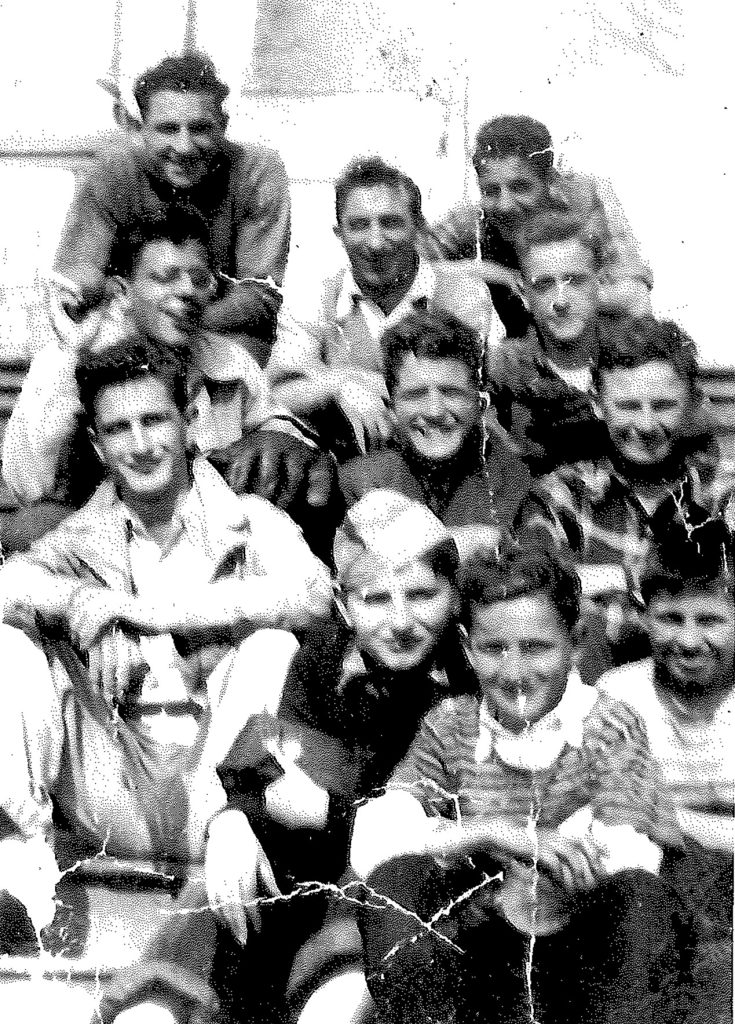
On the front steps of the South Side Boys Club C. 1946-47
The South Side Branch Boys' Club was first inaugurated by Morton Fuerst in 1943. It all began with a games room, woodworking shop, and a director's "cubby-hole" office in the basement of the old Jefferson School located at 50 Weyman Avenue. The rest of the building housed city departments such as the Commissioner of Civil Service (George Boardingham), the Council for Unity, the Society for the Prevention of Cruelty to Children, and a clothing department that issued clothing to the needy on welfare. Blanche Emerson was the supervisor in charge of the building. This club was an “on and offer” periodically, being closed and then opened again, as it was very difficult to find or keep a director. Most of the eligible men were in service, and the salary was much too small. Manufacturing plants for the war effort were springing up everywhere, and working around the clock and the salaries were quite satisfactory.
After returning from service in 1946 — after 2.5 years in the China-Burma-India theater of operations — I was asked by Mr. Fuerst to serve as director of the South Side Club instead of returning to Feeney Park as assistant to Hank "Deck." I became the first full-time director there. Within a two-year period, the City of New Rochelle saw the increasing need for such services.
Due to increasing activity and enrollment, they finally relented and gave the Boys' Club two rooms on the second floor, adjacent to a small auditorium. One room was used as a junior games room, and the other as a senior games room. A small office was added to one corner of the senior room using glass walls or sheetrock, which became the director's office. From this vantage point, the director could work at his desk and still observe all the activity in that room. Most of the credit for the growth of the South Side Branch should go to Attilio Perri. Perri was a student at I.E., Young High School and transferred from Feeney Park to the South Side Club when I became director. Attilio was very innovative and way ahead of his time, and as my assistant, he played a major role in the development of the South Side Boys' Club.
Perri immediately suggested removing the chairs, which were screwed down in the auditorium, tearing down the very small stage, and converting the area into a gymnasium. Backboards and baskets were put up on the walls, and a small gymnasium was now in use. There was one drawback: the second floor could only be used at night because city employees complained about the noise during the afternoon when they were working. Despite this, we began a very intensive basketball and boxing program. Bill Smith volunteered to coach the SSBC (South Side Boys' Club) basketball team, which was entered in the city recreation league. They went on to win the city intermediate championship twice. "Nolfi" Vaccaro, who lived in the area, coached the boxing team and gave many hours of volunteer work to the South Side Boys' Club. Vaccaro and Perri put together a great boxing team, which eventually upset the heavily favored Feeney Park boxing team for the Nicholas R. Jaye Memorial Boxing Trophy.
Many successful young men have emerged from that South Side Boys' Club experience—successful in athletics, education, politics, medicine, and more. Anthony Pappalardo, Attilio Perri, Frank "Sonny" Fodero, Frank Henderson, Ara Froudian, John V. Wilson, Jimmy Nole, Al Ryder, George Langlitz, John Kassara, and Joe Maida are just a few of the many young boys who turned out to be great men.
During those years (1945-1952), I worked closely with Hank Eck. He began a successful program of inter-club activities involving Feeney Park, the South Side, and Remington. This developed a closeness, a cohesiveness between the three clubs. The Ladies Auxiliaries merged into a united auxiliary and sponsored fundraising programs working together. This was a very bright era in the history of the Boys' Clubs of New Rochelle.
In 1952, for financial reasons, and with two children and a third on the way, I announced my resignation from the Boys’ Club to accept a position as a custodian at J. Young Junior High School. After one year as a custodian, I began working for a photoengraving company in Manhattan, which turned out to be a very successful and lucrative career. My resignation in 1952 came at a Communion breakfast, which was part of a very busy week of programs celebrating National Boys’ Club Week. The kids were stunned; no one had any inkling that this was going to happen. It turned out to be a farewell party and a Communion breakfast combined. We had quite a guest list, with notable figures such as Bruce Gehrke and Ed Janowski of the NY Giants, Frank Graham, sports editor of the New York Journal-American, Sal Dibuono, Bonnie Briar Country Club golf professional, and Pat McGowan, sports editor for the Standard Star.
From 1952 to the 1970s, numerous directors worked at the South Side Club, but none lasted for any significant length of time until Sal Laperra was named director. As the popularity of the South Side Branch grew, it became apparent that more space was needed. The city allocated the entire building for the Boys' Club and moved all city departments into the new City Hall, which was the Albert Leonard Junior High School, and for a short time, Albert Leonard High School. After the new Boys' Club was built at Feeney Park, the residents of the South Side became restless, declaring that their club was unsafe and in need of costly repairs. They campaigned for a new building.
A plan was devised by the city, with a lot of lobbying from the YMCA followers and officials, to build a community center and allocate a small portion for the Boys' Club, with the greater portion going to the YMCA. Since some influential people in city hall and on the YMCA board of directors were also members of the Boys' Club, they pushed relentlessly for that plan.
The YMCA emerged from this situation with a beautiful new building from the city, complete with the latest Nautilus equipment, a swimming pool, and other gifts. The Boys' Club, however, received what was left—practically nothing. When the YMCA sold their original building for a significant sum of money, the city felt entitled to a portion of that money in return. The YMCA flatly refused, enjoying a free ride at the taxpayers’ expense.
I protested bitterly at meetings held at the South Side. I wrote a stinging article outlining some of the pitfalls that might occur as a result of this proposed plan. This article was printed in the Standard Star, almost half a page in the Viewpoints section, on October 31, 1981. A copy of that letter will be included in this report.
Briefly, I suggested that they build a smaller, one-story building so that another floor could be added later when the economy allowed for it. I argued for a Boys’ Club, not a community center. All the drawbacks of this merger that I predicted have materialized since this building was constructed in the 1980s. Other problems, which I did not foresee, also emerged. But it is too late now.
In conclusion, I would like to state a few points and thoughts that I neglected to put in my original report. The training and coaching of the boxing team and the tumbling team were beneficial both to the kids and the club. The boxing and tumbling teams started receiving invitations to perform at fraternal and business club meetings. They always put on a great show, and the Boys’ Club would receive much-needed contributions.
The big deal in the late 1930s was when the kids began getting invited to entertain the soldiers at Fort Slocum. It was such a thrill to ride the ferry to the fort and perform for them. Money was very scarce and tight during those years and hard to come by, but Fort Slocum kept the Boys’ Club well-supplied with athletic equipment such as baseballs, hardballs, softballs, bats, basketballs, boxing gloves, etc.
Since 1929, the Boys' Clubs of New Rochelle have been training and molding young boys and girls by teaching them values. When these boys and girls first came to the club, they were tottering on that fine line between success and failure. The goal of the Boys' Club has always been to help kids cross that line and avoid falling below it. The Boys' Club has always been called "a home away from home." It always was—and always will be.
Has it been successful? Just look around you, and you will see great doctors, lawyers, businessmen, educators, athletes, clergymen, engineers, law enforcement officers, etc. We received their training in the Boys' Club. These professionals were fortunate to get the opportunity to go on to higher education. Yes, they are all successful people. Equally successful, however, are the many former members who were able to thrive despite not having the opportunity to pursue formal education. Many of them have succeeded in various trades, raising families and contributing to society.
Unable to go on to receive a college education for financial or personal reasons, the Boys’ Club experience made them fine ladies and gentlemen, good parents, and most of all, good citizens—a credit to their community.
This report was compiled as suggested by Oldtimer Charles "Charlie" DeJulius. It was put together from newspaper clippings and experiences deeply embedded in my mind. I believe that all the facts are entirely as they happened, and if you feel that there are errors, please correct them. I can only write about the years when I was actively and deeply involved on a day-to-day basis. I apologize for any typographical errors; typing is not one of my better talents.
Respectfully Submitted, Willie Lucia
February 20, 1993
